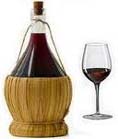Plates - 3
from Italian Traditional Food
Development of plates
<<Previous Page 3 Next
>>
Continuing the potted history of plates ...
Chelsea porcelain - the early and
best years
Talking of plates it's appropriate to link together Chelsea and Derby, two great names in English
porcelain, because for a time their fortunes were shared. The Chelsea factory was started in 1745 by an Englishman
named John Gouyn, in partnership with a Huguenot silversmith, Nicholas Sprimont. Gouyn had gathered some knowledge
of the making of soft paste porcelain while in France, and on his return to England he brought workmen from
Staffordshire - already an important centre for pottery - and set up for himself in London.
It's odd, as one distinguished collector remarks, that the first
venture in any field should be the best, but the early Chelsea wares are now considered the finest collector's
pieces, a fact reflected by the prices they fetch in the world's salerooms.
The end of an era
In 1749, or thereabouts, the partnership came to an end and so did
the first Chelsea factory, but the worthy Staffordshire workmen then started one of their own and, within two
years, Nicholas Sprimont was back in business. He had spent his time evolving new shapes and designs which not
unnaturally resembled the silver of the period. But the influence of the Meissen factory was strongly felt and
Chelsea plates, bowl, dishes and tureens were turned out in shape of apples, pineapples, cauliflowers, and
lettuces. Invention didn't stop there, and Chelsea tureens are to be found disguised as rabbits, ducks, fish and
even eels.
Delicately realistic paintings of flowers, fruit and their
attendant insects appeared on plates, and many of these designs were taken from a book
illustrating the flowers to be found in Sir Hans Sloane's Chelsea garden, which accounts no doubt for their
botanical exactness.
Relocation to Derby
Then, in 1770, when the influence of Meissen had declined and
Sevres was making its more elaborate impact on the decoration of English porcelain, when gilding had been
introduced and the botanical plates had acquired gilt rims, William Duesbury bought the Chelsea factory. Many of
the workmen and the original moulds were transferred to Derby, where he had been manager of the firm for fifteen
years. This move, coupled with the fact that very little is known about the precise work of the early Derby
factory, explains why it is difficult and even impossible to tell which of the porcelain came from Chelsea and
which from Derby.
Page 4 of this Italian Traditional Food
article on plates can be found on the next page.
<<Previous Page
3 Next >>

Copyright © 2009 -
. All Rights Reserved Worldwide. Italian Traditional Food
You may not reprint articles from this website
without the written permission of the site owner.
Disclaimer: Articles on this
Website are provided for information purposes only. Italiantraditionalfood.com does not accept any responsibility
or liability for the use or misuse of the article content on this site or reliance by any person on the site's
contents.
| 


 Digg
Digg Stumbleupon
Stumbleupon Google Bookmarks
Google Bookmarks Delicious
Delicious Twitter
Twitter Facebook
Facebook Yahoo My Web
Yahoo My Web Reddit
Reddit